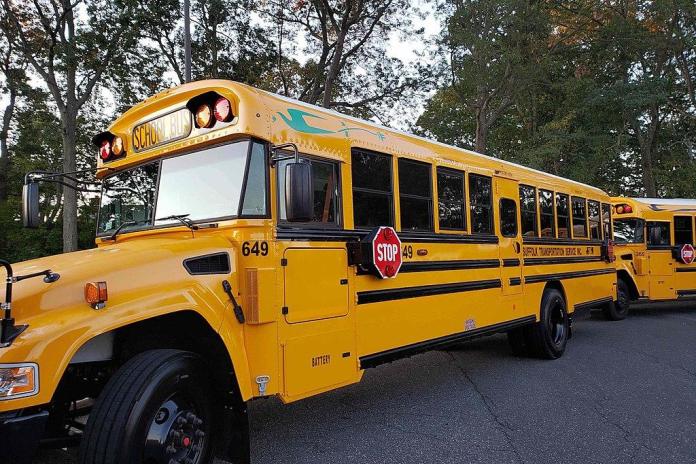Electric School Buses Qualify for More Than $9 Billion in Funding – and That Doesn’t Even Include Tax Credits
School districts across the United States have an unprecedented opportunity to provide a clean ride for their kids and communities.

This article originally appeared in ACT News.
Funding for Electric School Buses
With more than $9 billion in federal and state funding available for electric school buses (ESBs), school districts across the United States have an unprecedented opportunity to provide a clean ride for their kids and communities. Today, ESBs cost more than their diesel-burning counterparts. And, while the total cost of owning ESBs is expected to reach parity with diesel-burning school buses later this decade, funding programs play a critical role in making this technology more accessible in the short term.
There is a wide array of funding opportunities for ESBs, including the historic clean energy investments in the Bipartisan Infrastructure Law (BIL) and Inflation Reduction Act (IRA). The most extensive funding program for ESBs to date comes from BIL through the Environmental Protection Agency's (EPA) Clean School Bus Program (CSBP), which provides $5 billion over five years for low- and zero-emission school buses and includes prioritization for underserved school districts. With two funding rounds already awarded, CSBP has delivered almost 5,000 ESBs to school districts, or 55% of all committed ESBs! The fourth round of CSBP is expected to open in fall 2024, expanding access for even more districts to provide a cleaner ride for their students.
Additionally, one of the most recent federal funding opportunities is EPA’s Clean Heavy-Duty Vehicles Program (CHDV), including $400 million for projects serving nonattainment areas and $700 million dedicated to school buses. Applications are due July 25, 2024; apply here.
More funding opportunities for ESBs can be found using the Electric School Bus Initiative's Clearinghouse of Funding and Financing Opportunities.
In addition to the funding highlighted above, school districts and contractors can receive the Qualified Commercial Clean Vehicles (45W) tax credit for ESB procurement, and select projects can receive the Alternative Fuel Refueling Property (30C) credit for associated charging infrastructure. In a significant departure from the design of prior clean energy tax credits, IRS has enabled tax-exempt entities, like school districts, to receive tax credits through a new mechanism known as “elective pay.” Note that the tax credits expire in September 30, 2025, and June 30, 2026, respectively. Additionally, on August 21, 2025, IRS provided new information about the term “acquired.”
Stacking Funding Opportunities
Of the more than 700 school districts and fleet operators that have already embarked on their ESB journeys, many have found success by stacking several available funding options. Cherokee Central Schools, which serves the Eastern Band of Cherokee Indians, and their school transportation provider Cherokee Boys Club demonstrated the power of stacking funding opportunities. Through the EPA's Diesel Emissions Reduction Act (DERA) grant and a vehicle-to-grid technology pilot program from their electric utility Duke Energy, Cherokee Boys Club procured four ESBs and the necessary infrastructure.
Financing Can Bridge the Gap
As momentum for the ESB transition continues to rise, it is crucial to look beyond funding to financial solutions that can scale electrification. Blended funding and financing approaches — which leverage a combination of funding awards, financing and annual transportation budget funds — are gaining a successful track record, as modeled by Beaverton School District in Portland, Oregon. There, the district combined funding they received from DERA, Portland General Electric, and Oregon's Department of Environmental Quality with bonds to procure the ESBs they have on the road today.
New federal initiatives are opening doors for historically underserved districts to access financing previously out of reach. One tectonic shift in the financing landscape is the recently established Greenhouse Gas Reduction Fund (GGRF). With $20 billion awarded across eight organizations, the GGRF can help underserved communities deploy clean energy and climate-friendly solutions in their neighborhoods. For ESBs, the GGRF could translate to solutions like bridge loans to districts, ensuring they have access to the necessary capital to purchase an ESB while they wait for tax credits to hit the books. GGRF bridge loans or other financing solutions can model the U.S. Department of Agriculture's Community Facilities Program approach to mixing financing, grant funding and guarantees, depending on the needs of the community.
The fusion of various funding and financing avenues presents a promising path for widespread procurement of ESBs. Equitable access, prioritization and multiple options for funding opportunities can help ensure underserved communities are among the first to benefit from these investments in clean transportation. This will pave the way toward a more sustainable future while dismantling inequitable systems that disproportionately concentrate air pollution and its harmful effects in historically marginalized communities. As the transition to ESBs continues to grow, WRI’s Electric School Bus Initiative has a suite of free resources to help communities across the country access the opportunity to electrify.